So, it’s the time of year out here in the Maritime Northwest where periodic nice days start to happen. A few legitimately sunny Spring days in Seattle send thoughts to the veggie patch, and gardeners everywhere start running to buy plant starts.
This can become a caveat emptor situation pretty fast, because baby plants are, in the best of circumstances, delicate and fragile things. In poorer circumstances, you’d be better served taking $4 and burning it than buying a crappy veg start, because then at least you would only be wasting your money, not your money and your time.
Because let’s face it: you are buying starts to save time. You are either jump-starting the season (saving time in ground) or delegating the task of raising your own transplants (saving time beforehand).
So the last thing you want is for the extra money you are spending on starts as compared to seed to not save you time – either because the start itself fails or because the plant is a poor choice to transplant anyway.
Here’s a few key things to remember when you are surrounded (and possibly overwhelmed) by the seedling display.
First Things First: Location, Location, Location
Look around. Do you see something like this?
If you are at a local nursery with a large enough selection of vegetable starts to have an organic option, you are in a good place.
This place should also have helpful, passionate experts who can answer your questions. It should be dedicated to keeping locally grown and raised plant starts in good condition until they are purchased. This means the store pays staff to water and tend to the seedlings, and if that means your starts are a buck more expensive than at Home Depot, you suck it up and pay the extra buck.
I have said it before and I’ll repeat myself: do not buy your vegetable starts at the Big Orange Box or the Big Blue Box. You may buy your perennial shrubs and drip irrigation supplies and raised-bed timber at the chain hardware stores if you want, but please not veggies.
Cost-Benefit Analysis
Sometimes the extra money for starts vs. seeds just flat is not worth it.
Like here:
Someone is banking – literally – on your ignorance here. That’s $4 for a 4-inch pot of nasturtiums. In the Pacific Northwest, nasturtiums are a freely self-seeding flower with almost-but-not-quite invasive tendencies. One small packet of cheap seed will literally keep you in all the nasturtiums you will ever need for the rest of your gardening life.
Here’s another one I think is never worth it to transplant: mesclun mix.
Cut-and-come-again crops like this are sown in broad swaths and the idea is that you “mow” a section as needed to harvest, and then the plants regrow a few times.
These crops are a very poor choice to buy as transplants. You cut the plants when they are about this size, so there is almost no advantage to buying a start. Stick to relatively cheap seed blends for this kind of crop, and sprinkle a small new patch of soil with your seed blend every 3-4 weeks.
I adore arugula. Love it! I plant it everywhere. It germinates in about 15 minutes and grows to this size in about 5 days. Ok, slight exagerations but this is another crop that is grown in cut-and-come-again swaths. Not a good choice to buy as seedlings.
Watch The Roots
True story: I was at my local nursery snapping the photos for this post and a couple next to me was looking for beet seedlings.
“Where are the beets? These look like beets. These are beets, right?” the husband asked the wife.
The husband got a blank look from the wife, so I jump in like the a-hole who can’t keep her mouth shut: “Those are red cabbage seedlings, actually. Beets are up here. This is Chiogga, a fun candy cane striped beet. And this is a dark red variety. But hey, you know, beets generally do really well from seed and aren’t always the easiest things to transplant. In general, you know, the root vegetables don’t like to be transplanted very much. Do you know where they sell the seeds?” And I point towards the seed racks.
At this point I’m getting the look from the husband. It’s a look that says, “I’m twice your age and really don’t like it when kids I’ve never met correct me in front of my wife. And also, why are you so weird? You’re weird, beet girl, you know that?”
So here’s your rule of thumb: if you can’t tell the difference between a red cabbage seedling and a beet seedling from fifteen feet away, you are not allowed to buy root vegetables from starts. You must direct sow.
Even if you pass the beet test, you best think very, very hard before you buy carrot starts:
Because…carrots? Really? Beets can be done, very carefully, from transplant, because they bulb at the top of the soil, but I think carrots from transplant are just silly.
Root veg warning exception: onions. Onions have roots which seem like they’ve been sprayed with detangler or something. Onions transplant very well. Expect that all the soil will totally fall away from the white roots. That’s normal, and doesn’t seem to phase onion transplants too badly.
No, You Can’t Save It
Sometimes you’ll see starts that just look bad. This tatsoi is an example of a very stressed little plant. The older leaves are totally yellow and if you look closely you’ll see the seedling is already bolting. This is an example of a plant where you should just burn your money rather than buy it and “give it a try.”
Any time you see a seedling with a floret already developed do not buy that plant. Teeny little broccoli or cauliflower head on the plant? That is not an adorable head start. That is the plant abandoning all hope for a better life and throwing a seed stalk in the hopes that maybe, just maybe its progeny will find root in something that isn’t a 2″ deep plastic pot. Pass.
Here’s another bolting seedling I saw, this time from what looks like an Asian mustard green in a mesclun blend.
What’s The Un-Potting Plan, Here, Anyway?
Some seed growers are very careful about thinning their seedlings and some aren’t. If I have a choice, I will always, always choose well thinned seedlings over a crowded tangle like this:
What’s the chance that you’re going to be able to get each of those seedlings separated and still keep some root mass on each of them? Pretty much nil, right?
Here was one grower’s broccoli seedlings in an undivided pot. With this kind of start you have to break apart the soil around the individual seedling in order to separate the start for transplanting. Look how jumbled up all the stems and root systems are.
Now compare this start, grown in the exact same size and shape of pot:
Breaking these seedlings apart will be easy because there is one very nice looking start in each corner. These are great looking starts!
No Supermodel Seedlings
I know tall and skinny is good for runway models, but it’s not good for seedlings. A super leggy plant, like this, has probably been grown “hot,” meaning with lots of supplemental bottom heat and probably not enough strong light.
Result: weak plant tissues that will be prone to breaking during transplant and will likely suffer massive transplant shock.
You really want your ideal seedling to have more of a strong and stocky physique: think Gimli-the-dwarf, not Giselle-the-Supermodel.
That’s it! There are some wonderful, well raised starts out there, but to get the best results, you have to remember that all seedlings are not the same, and you have to be choosey.
8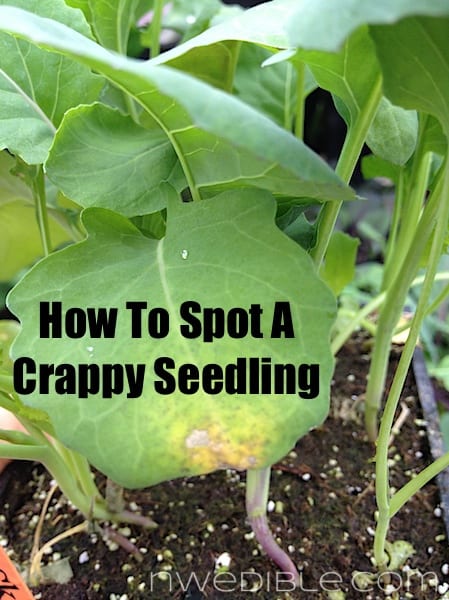


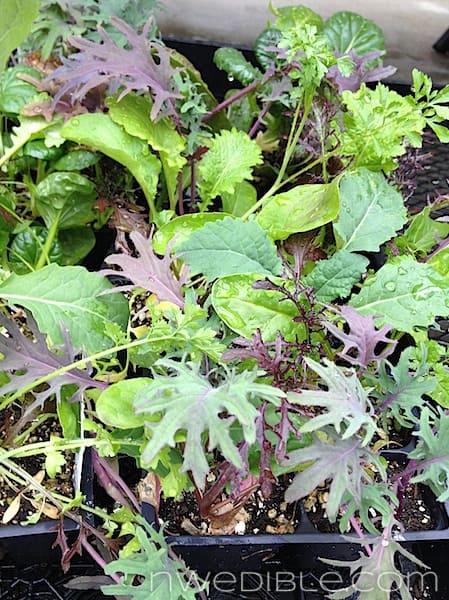
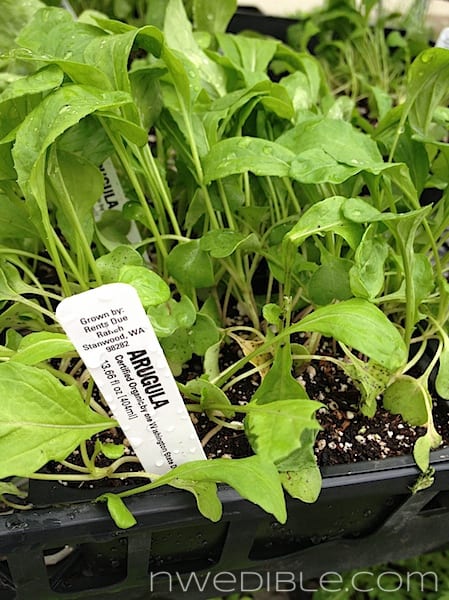
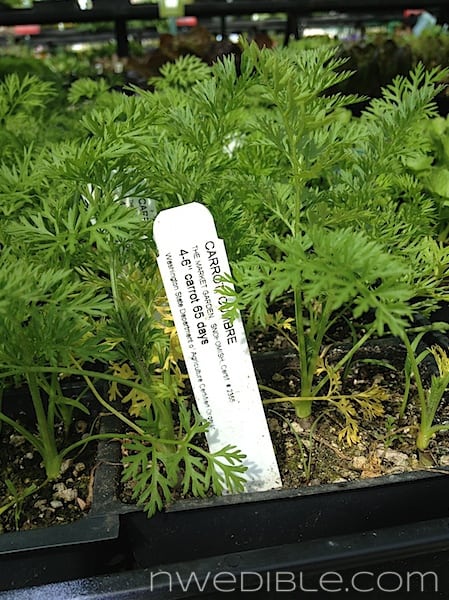
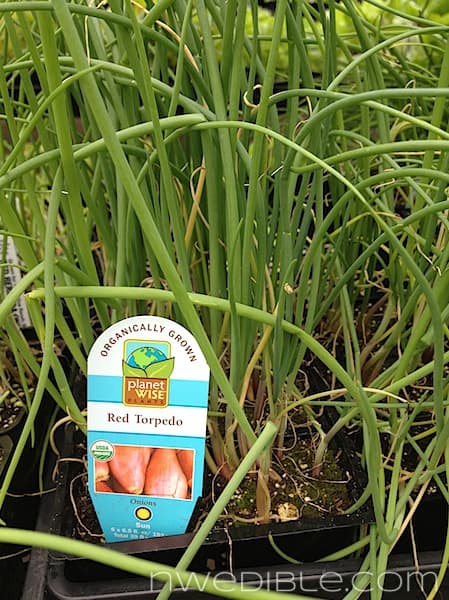
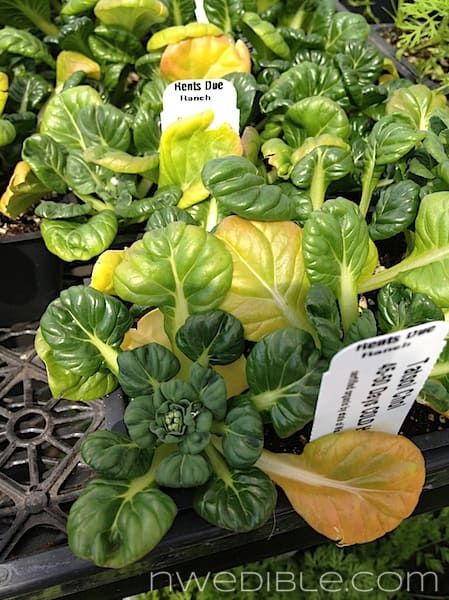



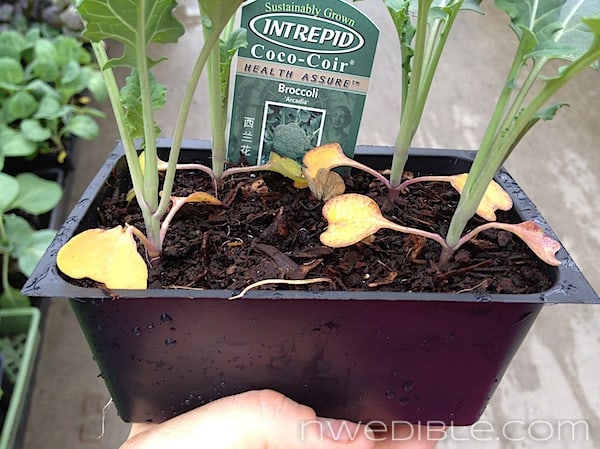
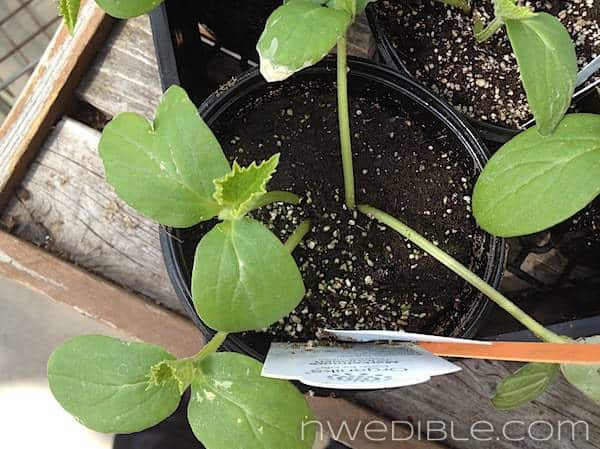
Thank you for another great posting. This year I’ve already had to reseed my radish and peas – I rushed the first seedings just to finally get my hands dirty again – typical gardening impatience for me. Keep up the great work.
Thanks Erica. That is really helpful advice.
excellent article…still laughing…seriously, i have never seen beet or carrot starts…
If she hadn’t had pictures, I would have never believed it. Carrot starts! HA!
Ahh, so much I didn’t know! I am guilty of beet and arugula transplant, no wonder they all died.
Nice researched post (that sounds like a spam comment, I know, promise it’s not). 🙂
I have such a hard time in nurseries biting my tongue. It’s so bad I just don’t go to them anymore. I start everything from seed and if I need a perennial shrub/tree/groundcover I go to the wholesale nursery because you can only shop there if you know what the hell you’re doing.
I don’t know if they sell Bonnie plants in your area, but just to put the word out, I recently found out Bonnie plants are all grown from either heirloom seeds or hybrids, no GMO. I don’t understand why they haven’t made this a big selling point, but it is clearly stated on their web page:
http://bonnieplants.com/our-story/the-greener-grower/
I bought Bonnie Plants at the big Orange store a few weeks ago. Good hardy plants.
I brought them home and transplanted. I am now seeing flowering on my plants…and I have some baby cherry tomatoes already ( I do live on the Gulf Coast of FL).
So far my other hybrid tomato (a larger variety for sandwiches) and my bell pepper plant are thriving and I am not having any issues with the Herbs I purchased as well.
Bonnie grows a quality plant.
were fortunate here to have lots of organic transplants readily available.. and smart enough growers that dont’ even try and sell root veggie transplants. I personally have a grow set up and start seeds.. the ONLY ones I have a battle with EVERY year are the onions and leeks. I seriously cannot seem to grow them from seed.. *sigh*
excellent post as per usual!
I really appreciate your posts they are so down to earth helpful and timely. It’s like having a wise gardening friend teach you what you need to know. Thank you!
Weird beet girl….bwa ha ha. You kill me.
I just start everything from seeds, then I know what I’m getting, but I have a longer growing season, so I’m not trying to get a head start. I use a little plastic greenhouse to get started a little earlier in spring though.
Thank you for this posting! These postings are fantastic and very helpful… as a first year big gardener and DIY anything convert I really appreciate it!
Just in case anyone reading all this doesn’t know, most plants with tap roots like squash don’t like being transplanted. They can be if you are really careful, but getting them direct sown by may 1 will result it a better plant. Great info though and next time you are at the store, don’t avoid the weird beet girl, ask her what to buy!
Crikey, what a GREAT post … thanx for this! Haven’t ever read a post that described it better [including all the chuckles, you weird-beet-girl you]. I worked for years in a plant nursery & sold hundreds of six-pak veggies to folks who had all the questions you are addressing here. Some days were just ultimate tests in patience. Fortunately, our nursery had very high quality control standards so that tatsoi would have been tossed on the back rubbish heap long ago. Anyhoo, had a fine time reading this, not only walking down *memory lane* but learning new things as well … like the ease of detangling onion starts … who knew?!?!
Great article on seedlings, very helpful and fun to read too. I felt sorry for that poor little broccoli seedling giving up on life already!
Wow. This is enormously helpful. Thanks for taking the time to get through all this.
I admit that I frequently buy starts for the very reason you explore… not enough time or patience. But, that’s about to change.
Thanks, Erica.
Excellent advice! I’m one of those who has had disappointing starts fall apart on me, and I couldn’t figure out what I was doing wrong.
Good advice.
I buy my starts at the Farmer’s Market– I have almost always been happy with them; they usually are varieties that do well in my area.
I decided to do starts this year because I can’t seem to grow lettuce from seed (indoors) to save my life! I only bought a few leaf lettuce starts, and they’re getting a beating in this weird spring we’re having. I think I’m just going to have to learn to be patient and seed directly in to my garden when the weather stabilizes. This post was so enlightening! Thanks for the help!
Great and informative post. Thanks, beet lady!
Last year I took a job at a commercial greenhouse and left after having only worked one day. Those big box seedlings and starts are so cheap because they are grown on the backs of sweatshop labor that is run much like a concentration camp, and I’m only slightly exaggerating. There is no love put into growing those plants, and the boss only wants to extract the most work out of the people for as little money as possible.
I KNOW what nursery you were frequenting because I go there also!! This year I have basically started everything from seed with a few exceptions (tomatoes and peppers). So far so good except the cold snap dropped my cucumbers even in my greenhouse (unheated). So I am starting over again.
I completely know what you mean by weird beet girl but I have also been weird flower girl or other veggie girl. I enjoy it when someone ask me stuff I know the answer to and then they think I work there – score!!
Thanks for that terrific post! I actually signed up for a plant start CSA (genius, right???) and am getting timely starts delivered to my door each month. It’s super cool and a good way to get some gardening experience.
Great tips. My own starts are soooo exceptional this year. Gimli would be proud. Minor detail that they are several weeks too early :-/ I got lucky the last few years and really, what gardener can help themselves against the hope of growing things again? So we are experimenting on various cutting strategies with the “oldies” and have restarted everything, lol.
Great post.
I have found that for heat-loving peppers buying a few starts instead of seeds makes financial sense. I just want a few because they are so picky. I’d rather have one or two of a few varieties rather than a whole bunch of one kind. Given the price of good hybrid seed it makes more sense to buy a few nice plants from a grower who is blessed with a heated greenhouse or other setup.
The detangler analogy is hilarious. I love your info but also really enjoy your writing for its own sake.
One more thing I’d like to add – Please don’t compare your home-grown starts to the ones at the nursery. Yours should be timed for your growing season, not for saleability. Yours may look smaller but they wont be root-bound and dying to get out of the 4-pack. I experimented with flowering hanging baskets when I owned a small nursery – the ones with small buds (no color at sale time) did not sell but I got to keep them and had glorious blooms for the whole season unlike the early-bloomers that sold fast and died by late July…
I lurk mostly, but I lurk a LOT: I just love your blog. You come up with the most pragmatic and informative posts ever, and the humor is just a fantastic bonus. Thank you.
Indeed a very useful information shared here especially for newbie gardeners and even not so newbie anymore.
This has been a very interesting and informative article for this newbie gardener. I’ve only grown tomatoes, zucchini, peppers, eggplant and some herbs and salad greens, so if I ever want to have a bigger garden this has been helpful.